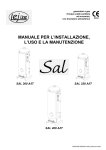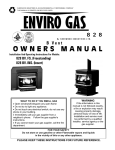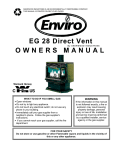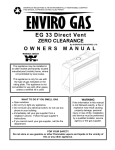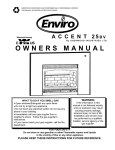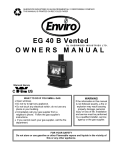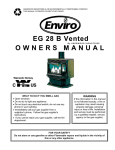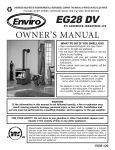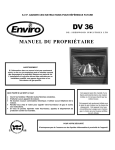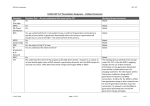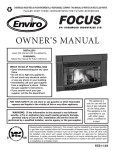Download Enviro 828 DV.FS. Operating instructions
Transcript
SHERWOOD INDUSTRIES IS AN ENVIRONMENTALLY RESPONSIBLE COMPANY THIS MANUAL IS PRINTED ON RECYCLED PAPER 8 2 8 By SHERWOOD INDUSTRIES LTD. Direct Vent O W N E R S M A N U A L Installation And Operating Instructions For Models: 828 MH (MOBILE HOME) 828 DV. FS. (Freestanding) 828 DV. INS. (Insert) WARNING WHAT TO DO IF YOU SMELL GAS • Open windows/Extinguish any open flame • Do not try to light any appliance. • Do not touch any electrical switch; do not use any phone in your building. • Immediately call your gas supplier from a neighbor's phone. Follow the gas supplier's instructions. • If you cannot reach your gas supplier, call the fire department. If the information in this manual is not followed exactly, a fire or explosion may result causing property damage, personal injury or loss of life. A qualified installer, service agency or the gas supplier must perform installation and service. FOR YOUR SAFETY Do not store or use gasoline or other Flammable vapors and liquids in the vicinity of this or any other appliance. PLEASE KEEP THESE INSTRUCTIONS FOR FUTURE REFERENCE. SAFETY PRECAUTIONS FOR SAFE INSTALLATION AND OPERATION OF YOUR "ENVIROGAS" ROOM HEATER, PLEASE, CAREFULLY READ THE FOLLOWING INFORMATION: • All "ENVIROGAS" gas-fired appliances must be installed in accordance with these instructions. Carefully read all the instructions in this manual first. Consult the building authority having jurisdiction to determine the need for a permit prior to commencing the installation. • To prevent injury, if the pilot or pilot and burners have gone out on their own, open the glass door and wait 5 minutes to air out before attempting to re-light stove. • NOTE Failure to follow these instructions could cause a malfunction of the fireplace that could result in death, serious bodily injury, and/or property damage. • Failure to follow these instructions may also void your fire insurance and/or warranty. • Always keep the area around these appliances clear of combustible material, gasoline or other flammable vapors and liquids. • These appliances should not be used as a drying rack for clothing or for hanging Christmas stockings or decorations. GENERAL • Installation and repair should be done by a qualified service person. The appliance should be inspected before use and at least annually by a qualified service person. More frequent cleaning may be required due to excessive lint from carpeting, bedding material, etc. It is imperative that control compartments, burners and circulating air passageways of the appliance be kept clean. • Due to the paint curing on the stove a faint odor and slight smoking will likely be noticed when the stove is first used. Open a window until the slight smoking stops. • Always connect this gas stove to a vent system and vent to the outside of the building envelope. Never vent to another room or inside a building. Make sure you use the vent pipe that is specified. Make sure that the vent is properly sized and is of adequate height to provide the proper draft. Inspect the venting system annually for blockage and any signs of deterioration. • Due to high temperatures the appliance should be located out of high traffic areas and away from furniture and draperies. Children and adults should be alerted to hazards of high surface temperatures and should stay away to avoid burns or clothing ignition. • Do not operate with cracked or broken glass. Under no circumstances should this appliance be modified. Parts that have to be removed for servicing must be replaced prior to operating this appliance. Only parts supplied by Envirogas should be used in this appliance and replacements should only be performed by a licensed or qualified service person. • Young children should be carefully supervised when they are in the same room as the appliance. • Clothing or other flammable material should not be placed on or near the appliance. • Never use solid fuels such as wood, paper, cardboard, coal, or any other flammable liquids etc., in this appliance. FOR YOUR SAFETY • A qualified installer, service agency or the gas supplier must perform installation and service. • Do not use this heater if any part has been under water. Immediately call a qualified service technician to inspect the heater and to replace any part of the control system and any gas control that has been under water. • Do not abuse glass by striking or slamming door shut • This installation must conform with local codes or, in the absence of local codes with the current CAN/CGA B149 installation code in Canada or the National Fuel Gas Code ANSI Z223.1.2 in the USA. • To prevent injury, do not allow anyone who is unfamiliar with the operation to use the stove. 2 TABLE OF CONTENTS 1 Code Approvals ...........................................................................................................................................3 Specifications...............................................................................................................................................3 2 Dimensions and Clearances to Combustibles .............................................................................................4 Zero Clearance Box Assembly .................................................................................................................... 5 3 Deciding Where to Locate Your Stove .........................................................................................................6 4 Assembly Instructions ..................................................................................................................................6 Fireplace Insert ............................................................................................................................................ 7 5 Installing burner control assembly ............................................................................................................... 8 6 Installation of Log Sets and Embers.............................................................................................................8 7 Electrical Requirements ...............................................................................................................................9 8 Gas Line Connection....................................................................................................................................10 9 Air Shutter Adjustment .................................................................................................................................11 10 Venting........................................................................................................................................................12 11 Mobile Home Fuel Conversion ....................................................................................................................19 12 Operating Instructions .................................................................................................................................20 13 Routine Maintenance ..................................................................................................................................21 14 Trouble Shooting.........................................................................................................................................22 15 Parts and Accessories ................................................................................................................................23 16 Warranty .....................................................................................................................................................24 17 Installation data sheet................................................................................................................................ 25 1. CODES AND APPROVALS • Direct Vent Type is designated by the suffix DV. This type of appliance draws all of the air for combustion from outside of the dwelling through specially designed vent pipe. These appliances have been tested by International Approval Services and found to comply with the established standards for DIRECT VENT WALL FURNACES in CANADA and the USA as follows: LISTED GAS FIRED GRAVITY DIRECT VENT WALL FURNACE ( 828 DV. Nat. & LPG. ) TESTED TO: ANSI Z21.44-1991 GAS FIRED FAN TYPE DIRECT VENT WALL FURNACE. CAN/CGA 2.19-M81 GAS FIRED GRAVITY 2 AND FAN TYPE DIRECT VENT WALL FURNACE. CGA INTERIM REQUIREMENT NO. 41-1991 DIRECT VENT GAS FIREPLACES CGA INTERIM REQUIREMENT NO. 55 - ADDITION REQUIREMENTS FOR DIRECT VENT FIREPLACES. CGA 2.17-M91 GAS FIRED APPLIANCES FOR USE AT HIGH ALTITUDE ENVIROGAS 828 DIRECT VENT UNITS; • • • • • • Have all been certified for use with either natural or propane gases. (See control panel and rating label.) Are not for use with solid fuels. Are approved for bedroom or bedsitting room. Must be installed in accordance with local codes if any. If none exist use current installation code CAN/CGA B149 in Canada or ANSI Z223.1 / NFPA 54 in the USA. Must be properly connected to an approved venting system. Manufactured (mobile) home installation must be in accordance with the Manufactured Home Construction and Safety Standard, UL 307B, Title 24 CFR, Part 3280 and/or The Standard for Manufactured Home Installations, ANSI A225.1/NFPA 501A. The unit must be bolted to the floor of the mobile home and must be electrically grounded to the steel chassis. FREESTANDING; • • Are approved for installation on combustible materials. Are not approved for closet or recessed installations. INSERT; • • are for installation in solid fuel burning fireplaces only; can be installed in Envirogas Zero Clearance Can kit 828-134 as a zero clearance unit. 3 2. DIMENSIONS AND CLEARANCES TO COMBUSTIBLES FIREPLACE INSERT: The stove can only be installed in a solid fuel burning fireplace . Mantle pillar to stove 10” Stove top to 8” wide mantle 12” Minimum firebox size W 26” x H 20” x D 20” (NOTE; standard size shown – optional 33”H x 46”W available) FREESTANDING: Side wall to stove 10" Rear wall to stove 4" Combustible to stove Top 22" Floor to stove 0" Corner clearance 2" Alcove depth 48" Maintain sufficient clearances for service and maintenance FIREPLACE INSERT / WITH ZERO CLEARANCE KIT ( Part # 828- 134 ) After deciding where to locate the fireplace insert you must frame an opening to except the Zero Clearance Box to reduce the clearance to combustibles. The framing dimensions are as follows; 32 1/4” wide, 29 3/8” high and a depth of 14 3/4”. The header at the top front of the opening must be a 2x4 on edge or a cut out in the 2x4 to maintain clearances to combustibles to the vent pipe. A minimum of 1 1/2” clearance must be maintained to the vent pipe. Before you install the Zero Clearance Box you must determine the finished hearth height.(including tiles, subfloor, etc.) The bottom of the box must be the same height as the finished hearth height. 4 ZERO CLEARANCE BOX ASSEMBLY; First take the kit from the box and place the surround panels aside so as not to damage the panels. There will also be a bag of screws, nuts and bolts in the box. The bottom section of the kit will have two 3 inch square boxes mounted to the bottom. First attach the bottom to the back with the screws provided, the hole should be located in the lower right hand corner looking at it from the front. The side can then be mounted to the bottom panel and the back panel. There are three (3) vee shaped standoffs with six screw holes in each, and they should be mounted on both sides as well as the back. There are also two (2) triangular support brackets that must be fastened to the inside of the box. There is a right hand and a left hand bracket, they should be mounted with the flanges pointing upwards. There are two long “L” shaped framing brackets that are screwed in from the outside front edge of each side. Each bracket has three adjustment holes depending on the thickness of the finished wall. The hole that is furthest forward are for a wall thickness of 1/2” drywall and the other holes are for other wall thickness up to 7/8” thick. The Zero Clearance kit must be flush with the finished wall. The next step is to put the top on the box. It will fit inside of the back and side panels and is screwed in from the outside. The two short vee shaped standoffs are screwed on to the top of the zero clearance kit. There are two large “L” type brackets that are to be screwed down on either side of the hole were the flue pipe exits the box. These two brackets are to locate the clamping bracket that holds the Simpson Duravent Telescoping pipe and allows the 828 unit to be disconnected and removed if the unit needs to be repaired. The next step is to attach the top extension to the Zero Clearance box. This is screwed to the top front edge. The top framing bracket is in turn screwed to the top extension. This top framing bracket has the same adjustment settings as the side framing brackets. Once the Zero Clearance box has been assembled it can be attached to the wall. Place the unit into the framed opening and make sure the box is plumb and level. The gas line then should be run through one of the three holes provided. The electrical cord and conduit (if a fan is to be installed) should also be run into the box at this time. The electrical box that is supplied with the fan kit will be mounted on the side, there are two holes inside the Zero Clearance box for mounting. The venting is the next step of installation. The pipe support on the top of the Zero Clearance kit is made to hold the telescoping pipe section. The clamp should be fastened 2” down from the top of the male end of the pipe. This will allow the top of the pipe to be held in place while the bottom section of pipe is attached to the stove. The wall can now be finished with drywall and mantel if so desired. Installing the 828 direct vent insert. The unit can be lifted up and put on the two support boxes on the bottom of the box and then pushed back into the box. There are two holes that must line up from the triangular supports inside the Zero Clearance box to the holes on the inserts side panel brackets and attached with the two screws provided. The vent pipe should then be connected to the top of the fireplace as well as the gas and electrical connections. The vented skirt can now be mounted to the bottom of the unit with the two 10 x 24 hex head screws provided, inserted into. The surround panel can now be assembled and bolted to the front of the stove. 5 3. DECIDING WHERE TO LOCATE YOUR STOVE FREESTANDING: • Locate the stove in a large and open room that is centrally located in the house. This will optimize heat circulation and comfort. • The stove should be located out of traffic, away from furniture and draperies and should have sufficient access for its safe operation and maintenance. • The flow of convection air can not be blocked • The stove can be installed on any combustible flat surface providing that it is installed on a metal or wood panel extending the full width and depth of the appliance. • Check the stove and flue system clearance requirements. Locate a position where the flue system of the stove can be properly installed without damaging the integrity of the building. e.g. cutting through a wall or ceiling joist. • Locate the stove where it can be accessed by a gas supply line. • Note: If the stove is equipped with the optional convection fan, the electrical cord is only 8 ft. (2.4 m) long. FIREPLACE INSERT • The fireplace insert model can only be located in an existing wood burning steel or masonry fireplace. The existing chimney must be lined using a Simpson Dura Vent sealed co-linear vent system using the Envirogas kit 828-135 (DV insert / co-linear adapter). 4. ASSEMBLY INSTRUCTIONS INSTALLATION Remove the packaging from the appliance, pedestal or surround panels and burner controls, check to make sure there is no damage. Carefully check the glass door. Do not use the unit if it is damaged. In the event damage is found, please report it to both the courier and your dealer as soon as possible. • Open the two hinged side panels, open the door by undoing the bolt, located on the right side (1/2 inch wrench). • Remove the log and ember set from the firebox. • Remove the two hold down clamps that attach the stove to its pallet ( #2 Robertson screwdriver ). These are hooked through the square openings immediately behind the side panels on each side of the unit. BOTTOM VIEW FREESTANDING • Place the stove on its back, on the pallet. • Back off the 4 screws ( 5/16 hex head located on the base) 2 turns. Place the pedestal so that the screws in the base of the stove engage the keyholes in the pedestal. Check to see that all screws are locked, then tighten with a 5/16 socket wrench. • Return unit to upright position. Complete the installation. Install the burner controls, log set, embers and optional fan kit as per the instructions in the upcoming sections. 6 PEDESTAL MOUNTING SCREWS FIREPLACE INSERT • Carefully clean the fireplace and flue before installing the stove. Failure to do so may result in fumes or dirt being blown into the room or insert and may cause a fire leading to death or serious injury. • If you are installing the optional fan kit, (see Installing Fan Kit) do so now. • If the fireplace has a dropped or uneven bottom, install the optional rear leveling legs. The leg brackets attach into the side rear of the firebox with the torx screws provided. Thread the 5” bolt into the retaining nut. Install the lock nuts. Back Rail • Install front and rear mounting rails using the screws provided (See figure 4). Mount the 3” vent coupling to the unit, making sure you have compressed the larger round gasket. Securely fasten (with a clamp or screws) the vent adapter box to the flexible 3” vent pipe liners previously installed in the chimney. Be careful not to over stretch the liners. Caution: do not mix up the intake with the exhaust pipe. Insert Adapter Box 3” Vent Coupling • Place the unit part way into the fireplace opening. Connect the insert's flexible gas line to the household gas supply using locally approved methods. • For units with optional fan, place the power cord so it can be connected to the power supply. • Push the unit into its final position in the fireplace. Adjust the leveling legs and tighten the lock nuts, insuring that the appliance is stable and level. • Push the insert adapter box under the rear rail then push down on the front of the box. Install the screw to secure. Front Rail • Remove the screws holding the hinged side flaps to the panel mounting brackets on each side of the unit (fig 5). • Loosen the 1/4" nuts (7/16" wrench) holding the stove top to the unit. Pull the top forward, lift up and remove. • Attach the surround panels together on the floor, using the two 1/4” nuts and bolts provided per side. • For units with optional fan, connect fan wire harness to the blower wires following the wiring diagram. • Place the assembled surround panel around the stove, in front of the surround mounting brackets. Make sure the top panel sits flat on the stove and the mounting holes on the side, line up. • Re-attach the hinged side flaps, screwing through the surround panel into the brackets. Re-install the top and secure. 7 5. INSTALLING BURNER CONTROL ASSEMBLY Remove the controls from box, check for shipping damage. Remove burner tray from controls (one screw on each side between burners). Open door. Remove grate rod by pulling up at each end. Remove the 2 screws behind the grate and one screw on each side of control opening in firebox. Extend flex gas line and place through hole in center of pedestal (freestanding and inserts) or through hole in right or left firebox side (insert only). Lower the controls into place at the back while pulling the flex line through on other side. Lower front into place, the control knob may need to be pushed in to allow burner controls to fit. Install the two side screws, then install the front screws through the grate into the firebox. Replace burner tray. Install the grate rod and logset. 6. INSTALLATION OF LOG SET and EMBERS Upon the first light up, watch for ignition to all burner ports. If a long delay is noted: a) First, wait for the appliance to cool down b) Open the front door of the appliance. c) Checks to Carefully reposition the embers making sure that burner ports are not plugged solid or blocked CAUTION: NEVER OPERATE THIS APPLIANCE WITH THE DOOR REMOVED INSTALLING THE LOG a. INSTALLING THE GLOWING EMBERS Carefully remove log from unit. Check to ensure there is no damage. It is very important to install this log in its proper position to insure safe optimum operating conditions. A bag of ceramic fiber embers is provided for use on the front burner ember tray. CAUTION: Use only the type of ember material supplied with this appliance. Due to the irregular size of the ember material there may be more than required. Use only a single layer. Do not pile embers. The use of other foreign materials on the burners may create dangerous conditions. If over time, through cleaning and servicing, these embers require replacement, contact your nearest ENVIROGAS dealer for replacement embers. Gently remove the ember material from the plastic bag. Spreading these pieces evenly across the front of the ember tray. Place a single layer of embers on top of the front burner. Carefully avoid any clumping or large buildups. Do not pack down, leave embers loose. 1. DO NOT PLACE EMBERS ON THE REAR BURNER. 8 Open the front door. 2. Place the log with Burnt Area forward on log supports. Locate the log by matching the bottom 3. pegs to the receiving holes in rear log supports. Close door securely 7. ELECTRICAL REQUIREMENTS The ENVIROGAS 828 Series will operate without an external electrical power supply. This model has a Millivolt gas control which uses the pilot flame to generate enough electricity to operate the main burners. CAUTION: Label all wires prior to disconnection when servicing controls. Wiring errors can cause improper and dangerous operation. Verify proper operation after servicing. FAN INSTALLATION OPTIONAL FAN Efficiency and heat output of the unit increases with the operation of the fan. • This appliance is equipped with a three-prong (grounding) plug for your protection against shock hazard, and should be plugged directly into a properly grounded three-prong outlet. DO NOT cut or remove the grounding prong from this plug. The appliance, when installed with optional blower , must be electrically connected and grounded in accordance with local codes or in the absence of local codes, with the current CSA C22.1 CANADIAN ELECTRICAL CODE Part 1, SAFETY STANDARDS FOR ELECTRICAL INSTALLATIONS, OR THE NATIONAL ELECTRICAL CODE ANSI / NFPA 70 in the USA. 9 8. GAS LINE CONNECTION AND TESTING WARNING: Only persons licensed to work with gas piping can make the gas connections to this appliance. This appliance is equipped with a 3/8” stainless steel flex line from the valve. This line may be routed through the hole in the rear of the pedestal, or on inserts, routed through the fire box sides. An adapter plate is available for installations that do not allow flex pipe through cabinetry. NOTE: Consult your local authorities and in CAN. the CAN/CGA-B149 (1 or 2) Installation Code, For USA gas installations follow either local codes or the current edition of the National Fuel Gas Code ANSI. Z223.1. The appliance and its shutoff valves must be disconnected from the gas supply piping system during any pressure testing where the pressure exceeds 1/2 PSIG (3.45 kPa) or damage will occur to the valve. The appliance must be isolated from the gas supply piping system by closing its individual manual shutoff valve during any pressure testing of the gas supply piping system at test pressures equal to or less than 1/2 psig (3.5 kPa). Always check for gas leaks with a soap and water solution or an approved manner after completing required pressure tests. ORIFICE SIZES, PRESSURES AND BTU'S The efficiency rating of this appliance is a product thermal efficiency rating determined under continuous operating conditions and was determined independently of any installed system. All models are equipped with a variable output gas control. NATURAL GAS PROPANE ORIFICES (Front / Rear) Manifold Press: Min. Manifold Press: Max. Supply Press: Desired Supply Press: Min. Supply Press: Max. BTU/H Input: Min. BTU/H Input: #51 DMS / #49 DMS 3.5"wc / 0.87 kPa 2.1"wc / 0.52 kPa 7.0"wc / 1.74 kPa 7.0"wc / 1.74 kPa 5.0"wc / 1.25 kPa 26,500 / 7.6 kW 21,000 / 6.15 kW #59 DMS / #56 DMS 10.0"wc / 2.49 kPa 6.2"wc / 1.54 kPa 13.0"wc / 3.23 kPa 11.0”wc / 2.74 kPa 10.5"wc / 2.62 kPa 26,500 / 7.6 kW 21,000 / 6.15 kW MOBILE HOME Manifold Press: 4.0"wc / 1.00 kPa 10.0"wc / 2.49 kPa In Canada and the United States these appliances are certified for altitudes of 0-4500 ft. / 1370 m. TO TEST VALVE PRESSURES NOVASIT VALVE: The pressure taps are located on the front of the valve through the control panel. (Left - manifold pressure, Right - inlet pressure). -Turn set screw counter clockwise to loosen, 2 turns. -Place 5/16" I.D. hose over pressure tap system. -When finished, release pressure, remove hose & tighten set screw. EUROSIT VALVE: The pressure taps are located through the left side of the pedestal on the left side of the valve (Rear - inlet pressure, Front - manifold pressure). NEVER USE AN OPEN FLAME FOR LEAK TESTING. 10 9. AIR SHUTTER ADJUSTMENT • • • There is a separate venturi air shutter for each burner The venturies have been set for installation at sea level to 4,500 ft. To adjust for higher altitudes: Remove the access cover plate, loosen the air shutter locking screws with a long screwdriver. Rotate the air shutters to the correct setting. The flame should be bright yellow in color and have a lively appearance. If sooting occurs on the glass then the venturi opening may need to be increased. 11 10. VENTING VENT TERMINATION CLEARANCES A= Clearance above grade, verandah, porch, deck, or [balcony (*12 inches (30cm) minimum] B= Clearance to window or door that may be opened [*12 inches (30cm) minimum] C= Clearance to permanently closed window [minimum 12 inches (30cm) recommended to prevent condensation on window] D= Vertical clearance to ventilated soffit located above the terminal within a horizontal distance of 2 feet (60cm) from the center-line of the terminal [24 inches ( 60cm) minimum] E= Clearance to unventilated soffit [18 inches (45cm) minimum] F= Clearance to outside corner [12 inches minimum] G= Clearance to inside corner [ 12 inches minimum] H= *Not to be installed above a meter/regulator assembly within 3 feet (90cm) horizontally from the center-line of the regulator I= Clearance to service regulator vent outlet [*6 feet (1.8m) minimum] J= Clearance to non-mechanical air supply inlet to building or the combustion air inlet to any other appliance [12 inches (30cm) minimum] K= Clearance to a mechanical air supply inlet [*6 feet (1.8m) minimum] L= *** Clearance above paved side-walk or paved driveway located on public property [*7 feet (2.1m) minimum] M= Clearance under verandah, porch, deck, or balcony [*24 inches (60cm) minimum **] *** A vent shall not terminate directly above a side-walk or paved driveway which is located between two single family dwellings and serves both dwellings ** Only permitted if verandah. Porch, deck, or balcony, is fully open on a minimum of 2 sides beneath the floor • As specified in CGA B149 Installation Codes (1991) Note: Local Codes or Regulations may require different clearances 12 These models have been tested and certified for use with SIMPSON DURAVENT DIRECT VENT TYPE "GS" PIPE FOR GAS STOVE. Kits are available for vertical venting or horizontal venting. It is recommended that a bead of RTV High Temperature Silicone be applied to each vent joint before installation. A MINIMUM VERTICAL LENGTH OF 24" TO THE FIRST 90 DEGREE ELBOW IS REQUIRED. WITH THIS MINIMUM VERTICAL RISE, HORIZONTAL RUNS OF FROM ONE TO FOUR FEET ARE PERMITTED TO REACH THE OUTSIDE VENT TERMINATION. VENTING TERMINALS CANNOT BE RECESSED INTO A WALL OR SIDING. FOLLOW THE VENTING SHOWN IN PRECISELY. These models have been tested and certified for use with SIMPSON DURAVENT DIRECT VENT TYPE "GS" PIPE FOR GAS STOVES. Kits are available for vertical venting or horizontal venting. It is recommended that a bead of RTV High Temperature Silicone be applied to each outer vent joint and milpac to each inner joint before installation. A MINIMUM VERTICAL LENGTH OF 24" TO THE FIRST 90 DEGREE ELBOW IS REQUIRED. WITH THIS MINIMUM VERTICAL RISE, HORIZONTAL RUNS OF FROM ONE TO FOUR FEET ARE PERMITTED TO REACH THE OUTSIDE VENT TERMINATION. BEFORE BEGINNING THE INSTALLATION TAKE CARE TO ENSURE AN APPROPRIATE OUTSIDE LOCATION FOR THE VENT TERMINATION CAN BE ACCOMMODATED. FOLLOW THE VENT LENGTH DIAGRAM PRECISELY. VENTING TERMINALS CANNOT BE RECESSED INTO A WALL OR SIDING. If extra elbows are being used, overall allowable length will be reduced by 3 ft. per additional elbow PLANNING YOUR INSTALLATION There are two basic types of Direct Vent System installations. The two types of installations are: Simpson Duravent Parts Number 908B Description 6" Pipe Length, Black 907B 906 (B) 904 (B) 903 (B) 902 (B) 911 (B) 945 (B) 943S 953 990 (B) 940 9" Pipe Length, Black 12" Pipe Length, (Black) 24" Pipe Length, (Black) 36" Pipe Length, (Black) 48" Pipe Length, (Black) 11" to 14-5/8" Pipe , Adjustable, Black 45° Elbow, (Black) Flashing, 7/12 to 12/12 Roof Pitch Storm Collar 90° Elbow, (Black) Round Support / Wall Thimble Cover Number 941 943 963 988 984 985 980 991 950 942 971 Description Cathedral Ceiling Support Box Flashing, 0/12 to 6/12 Roof Pitch Ceiling Firestop Wall Strap Horizontal Square Termination High Wind Horizontal Termination Vertical Termination High Wind Vertical Termination Vinyl Siding Standoff Wall Thimble Horizontal Termination Kit A Add suffix (B) for optional black parts as listed. Vertical Termination Horizontal Termination 13 When planning your installation, it will be necessary to select the proper length of vent pipe for your particular requirements. It is important to note when passing through a wall, the maximum allowable wall thickness is 10-inches (254mm), 1 ½ inches clearance to combustibles must be maintained. Select the amount of vertical rise desired for “vertical-to-horizontal” type installations. To determine the length of vent pipe required for vertical installations, measure the distance from the appliance flue outlet to the ceiling, the ceiling thickness, the vertical rise through the attic or second story, and allow for sufficient vent height above the roofline. For two story applications, A firestop is required at each floor level. If an offset is needed in the attic, additional pipe and elbows will be required. To connect the venting system to the appliance flue outlet, a twist-lock adapter is built into the appliance at the factory. HORIZONTAL INSTALLATION STEP 1. Set the appliance in the desired location. Check to determine if wall studs or roof rafters are in the way when the venting system is attached. If this is the case, you may want to adjust the location of the appliance. STEP 2. Direct vent pipe and fittings are designed with special twist-lock connections. Assemble the desired combination of black pipe and elbows to the appliance adapter with pipe seams oriented towards the wall or floor, as much out of view as possible. Place a bead of Mil-PAC on the outer edge of the inner exhaust pipe (non-flared end). Place a bead of high temperature silicone on the male edge of the outer pipe. Push the pipe sections completely together, then twist-lock one section clockwise approximately one-quarter turn, until the two sections are fully locked. The female locking lugs will not be visible from the outside, on black pipe. They may be located by examining the inside of the female ends as shown in FIG-10. NOTE: (1) Twist-lock procedure: four indentations, located on the female end of the pipes and fittings, are designed to slide straight onto the male ends of adjacent pipes and fittings, by orienting the four pipe indentations so they match and slide into the four entry slots on the male end. (2) Horizontal runs of vent pipe must be supported every three feet. Wall straps are available for this purpose. FIG. 10 FIG.10 STEP 3. With the pipe attached to the stove into the correct location, mark the wall for a 10 inch x 10 inch square hole. The center of the square hole should match the centerline of the horizontal pipe. Cut and frame the 10-inch x 10-inch hole in the exterior wall where the vent will be terminated. If the wall being penetrated is constructed of non-combustible material i.e. masonry or concrete, a 7-inch hole is acceptable. STEP 4. Position the horizontal vent termination in the center of the 10-inch square hole, and attach to the exterior wall with the four screws provided. Before attaching the Vent Termination to the exterior wall, run a bead of non-hardening mastic around the edges, so as to make a seal between the termination and the wall. The arrow on the vent termination should be pointing up, insure that the proper clearances to combustible materials are maintained. STEP 5. Before connecting the horizontal run of the vent pipe to the vent termination, slide the black decorative wall thimble cover over the vent pipe. STEP 6. Slide the appliance and vent assembly towards the wall, carefully inserting the vent pipe into the cap assembly. It is important that the vent pipe extend into the vent cap a sufficient distance with a minimum of 1 1/4” inch overlaps. Secure the connection between the vent cap pipe and the vent cap by attaching the two sheet metal straps extending from the vent cap assembly into the outer wall of the vent pipe. Use the two sheet metal screws provided to connect the straps to the vent pipe. Bend any remaining portion of the sheet metal straps back towards the vent cap, so the decorative wall thimble FIG-13 will conceal it. 14 STEP 7. Slide the decorative wall thimble up to the wall surface and attach with the screws provided. Apply decorative brass or chrome trim if desired. FIG-14. FIG. 11 FIG. 12 FIG-13 FIG-14 NOTES: (1) The four wood screws provided should be replaced with the appropriate fasteners for stucco, brick, concrete, or other types of siding. (2) For buildings with vinyl siding, a vinyl siding standoff (950), should be installed between the vent cap and the exterior wall FIG-12. Attach the vinyl siding standoff to the horizontal termination. The vinyl siding standoff prevents excessive heat from possibly melting the vinyl siding material. Note that the horizontal vent termination bolts onto the flat portion of the vinyl siding standoff. (shaded area in FIG-12), so that an air space will exist between the wall and the vent termination. NOTES: (1) The horizontal run of vent pipe must be level and should have a ¼ inch rise for every one foot of run towards the termination. Never allow the vent to run downward. This could cause high temperature and may present the possibility of a fire (2) The location of the horizontal vent termination on the exterior wall must not be easily blocked or obstructed. Termination clearances are as follows: (3) When installing a vent pipe in a chase the minimum clearances to combustible is 4” inches (100 mm). 15 VERTICAL INSTALLATION STEP 1. Check the instructions for required clearances (air spaces) to combustibles when passing through ceilings, walls, roofs, enclosures, attic rafters , or other nearby combustible surfaces. Do not pack air spaces with insulation. STEP 2. Set the gas appliance in the desired location. Drop a plumb bob down from the ceiling to the position of the appliance flue exit, and mark the location where the vent will penetrate the ceiling. Drill a small hole at this point. Next, drop a plumb bob from the roof to the hole previously drilled in the ceiling, mark the spot where the vent will penetrate the roof. Determine if ceiling joists, roof rafters, or other framing will obstruct the venting system. You may wish to relocate the appliance, or to offset, to avoid cutting load bearing members. STEP 3. To install the Round Support Box/Wall Thimble in a flat ceiling, cut a 10- inch square hole in the ceiling, centered in the hole drilled in Step 2. Frame the hole as shown in FIG-16. STEP 4. Assemble the desired lengths of black pipe and elbows necessary to reach from the appliance adapter up through the Round Support Box. Insure that all pipe and elbow connections are in their fully twist-locked position. STEP 5. Cut hole in the roof centered on the small hole placed in the roof from Step 2. The hole should be of sufficient size to meet minimum requirements for Clearance to Combustibles, as specified. Continue to assemble lengths of pipe and elbows necessary to reach from the ceiling Support Box up through the roofline. Galvanized pipe and elbows may be utilized in the attic, as well as above the roofline. The galvanized finish is desirable above the roofline, due to the higher corrosion resistance. STEP 6. Once the pipe sections have been joined, and run up through the hole in he roof, slip an elbow strap (Part-989) over the exposed sections, bend the support straps outwards, and push the Elbow Strap down to the roof level, as shown in FIG 17. Tighten the clamp around the Pipe section. Use a level to make sure the pipe is truly vertical. With roofing nails, secure the support straps to the roof. Seal the nails holes heads with non-hardening mastic. Trim the excess length of the support straps that extend out beyond the edge of the flashing. STEP 7. Slip the flashing over the pipe section protruding through the roof. Secure the base of the flashing to the roof with roofing nails. Use a non-hardening sealant between the uphill edge of the flashing and the roof. Insure the roofing material overlaps the top edge of the flashing as shown in FIG 17. Verify that you have at least the minimum clearance to combustibles at the roofline. STEP 8. Continue to add pipe sections until the height of the vent cap meets the minimum code requirements. FIG 22. Note that for steep roof pitches, the vent height must be increased. In high wind conditions, nearby trees, adjoining roof lines, steep pitched roofs, and other similar factors can result in poor draft, or down drafting. In these cases, increasing the vent height may solve the problem. STEP 9. Slip the Storm Collar over the pipe, and push it down to the top of the roof flashing as shown in FIG 17. Use the nonhardening sealant around the joint between the pipe and the Storm Collar. STEP 10. Twist lock the vent cap. FIG-16 FIG-17 16 NOTES: (1) If an offset is necessary in the attic to avoid obstructions, it is important to support the vent pipe every 3 feet, to avoid excessive stress on the elbows, and possible separation. Wall straps are available for this purpose. FIG18 (2) When ever possible, use 45° degree elbows instead of 90° degree elbows. The 45° degree elbow offers less restriction to the flow of flue gases and intake air. NOTES: (1) For multi story installations. A ceiling firestop (part 963) is required at the second floor, and any subsequent floors. FIG-19. The opening should be framed to 10-inch x 10-inch inside dimensions, in the same manner as shown in FIG-16. (2) Any occupied areas above the first floor, including closets and storage spaces, which the vertical vent passes through, must be enclosed. The enclosure may be framed and sheetrocked with standard building materials. However consult the appliance manufactures installation instructions for the minimum allowable clearance between the outside of the vent pipe, and the combustible surfaces of the enclosure. Do not fill any required air spaces with insulation. FIG. 18 FIG.19 FIG-21 FIG.20 FIG-22 17 CATHEDRAL CEILING INSTALLATION Step 1. Follow installation steps 1 and 2 under Vertical Termination. Step 2. Using the plumb bob, mark the centerline of the venting system on the ceiling and drill a small hole through the ceiling and roof at this point. From the roof, locate the drill hole and mark the outline of the Cathedral Ceiling Support Box. Step 3. Remove shingles or other roof covering as necessary to cut the rectangular hole for the Support Box. Cut the hole 1/8 larger than the support Box outline. Step 4. Lower the Support Box through the hole in the roof until the bottom of the Support Box protrudes at least 2 inches below the ceiling. (Fig. 18). Align the Support Box both vertically and horizontally with a level. Temporarily tack the Support Box in place through the inside walls and into the roof sheathing. Step 5. Using tin snips, cut the Support Box from the top corners down to the roofline, and fold the resulting flaps over the roof sheathing. (Fig. 20). Before nailing it to the roof, run a bead of non-hardening mastic around the top edges of the Support Box, to make a seal between the Box and the roof. Clean our any combustible material from inside the Support Box. Step 6. Complete the Cathedral Ceiling Installation by following the same procedures outlined in Steps 4 through 9 for Vertical Termination. FIREPLACE INSERT INSTALLATION Parts: 923GK 923F Chimney Liner Termination Kit Co-Linear Flex Connectors The Envirogas 828 insert may be installed and vented into any solid fuel fireplace that has been installed in accordance with the National, Provincial/State and local building codes and has been constructed of non-combustible materials. An approved throat connector must be installed, to ensure a tight seal, top performance, safety and efficiency. Carefully follow the manufacturer’s instructions, which accompany the chimney liner kit. Measure the height of the chimney before hand and purchase the appropriate kit. Never attempt to over stretch a flexible liner to accommodate the height of the chimney. Install sealed throat connector to prevent leakage of room air up through the chimney. Any flue damper must be removed or blocked permanently in the open position. The chimney must be clean, in good working order and constructed out of noncombustible materials. Make sure that all chimney cleanouts are tightly fitting and will not permit air to leak into the chimney. ZERO CLEARANCE INSERTS GS vent system Follow the vent installation instructions for Horizontal or Vertical installations using the 18 11. MOBILE HOME FUEL CONVERSION To convert from Propane to Natural Gas or vise-versa 1. 2. 3. 4. 5. 6. 7. 8. 9. 10. 11. 12. 13. • • • Disconnect the unit from the gas supply. Open the door and remove the logset. Remove the burner tray (2 screws) and the burner control assembly by removing the 8 screws holding it into the unit. Remove the control panel from the control assembly Undo the pilot tube and thermocouple from the valve. Remove the pilot assembly. Using a (10) mm wrench, undo the nut holding the pilot tube into the pilot assembly. Remove the silver colored pilot orifice and exchange it with the replacement orifice. Note: The NG orifice is stamped “51” the LPG is stamped10“30”. Re-attach the pilot tube into the pilot (caution: the brass nut rounds easily) Make sure it is tight. Re-install the pilot assembly and re-attach the thermocouple to the valve. Remove the nut on the gas regulator and place the black pin in the correct position for the fuel type, re-install the nut. Change the burner orifices with the alternate set NG #51 front #49 rear LPG #59 front #56 rear Re-install the control panel, to the burner control assembly Re-install the burner tray and logset. Re-connect the gas supply. When the unit is installed in a Mobile Home it must be grounded to the steel chassis or connected to a grounding rod. In a Mobile Home installation the unit must be bolted securely to the floor using the holes provided. Manufactured (mobile) home installation must be in accordance with the Manufactured Home Construction and Safety Standard, UL 307B, Title 24 CFR, Part 3280 and/or The Standard for Manufactured Home Installations, ANSI A225.1/NFPA 501A Holes for unit hold down screws 19 12. OPERATING INSTRUCTIONS FOR YOUR SAFETY READ BEFORE OPERATING WARNING: IF YOU DO NOT FOLLOW THESE INSTRUCTIONS EXACTLY, A FIRE OR EXPLOSION MAY RESULT CAUSING PROPERTY DAMAGE, PERSONAL INJURY OR LOSS OF LIFE. A) This appliance is equipped with a pilot that must be lit by hand by following these instructions exactly. B) BEFORE LIGHTING smell all around the appliance area for gas, and next to the floor because some gas is heavier than air and will settle on the floor. WHAT TO DO IF YOU SMELL GAS: • Do not try to light any appliance. • Do not touch any electrical switch; do not use any phone in your building. • Immediately call your gas supplier from a neighbor’s phone. Follow the gas suppliers instructions. • If you cannot reach your gas supplier, call the fire department. C) Use only your hand to push in or turn the gas control knob. Never use tools. If the knob will not push in or turn by hand, do not attempt to repair it. Call a qualified service technician. Force or attempted repair may result in a fire or explosion. D) Do not use this appliance if any part has been under water. Immediately call a qualified service technician to inspect the appliance and to replace any part of the control system and any gas control which has been under water LIGHTING INSTRUCTIONS STOP! Read the safety information above. • Turn off all electrical power to the appliance. 8. EUROSIT VALVE: Turn the gas control knob clockwise to the Turn gas control knob counter-clockwise to “off’ position. the “LO” position. Then turn knob to the desired 4. Open door. Wait five (5) minutes to clear out any gas. setting. Close door. If you smell gas including near the floor, STOP! Follow “B” in the above safety information. If you don’t smell gas go to next step. 5. Find the pilot located to the right between the front and rear burner. 6. Turn gas control knob counter-clockwise to “PILOT”. 7. Push the gas control knob in fully and hold. Immediately light the pilot by pushing the piezo spark ignitor. Keep knob depressed for about 30 seconds after pilot is lit. Release knob. If pilot goes out, repeat steps 4 through 6. WARNING The gas valve has an lockout device which will not allow the pilot burner to be re-lit until the 9. NOVASIT VALVE: thermocouple has cooled. Turn gas control knob counter-clockwise to • If the knob does not pop up when released, stop and the “ON” position. Flip burner switch to “ON” then immediately call your service technician or gas turn “HI / LO” knob to the desired setting. supplier. • If the pilot will not stay lit after several tries, turn the gas control knob to “OFF” and call your service technician or gas supplier. 1. 2. 3. 10.Turn on all electrical power to the unit NOTE: Check to be sure the pilot flame engulfs the thermocouple and that the burners light completely. TO TURN OFF GAS TO APPLIANCE 1. Turn the gas control knob clockwise to “OFF” DO NOT FORCE 2. Turn off all electrical power to the appliance if service is to be performed. 3. NOVA SIT VALVE: Flip burner switch to off. 20 13. MAINTENANCE AND TECHNICAL Periodically check to ensure that your "Direct Vent" system is clear. Periodically check the pilot and burner. Check to see that all the burner ports are clean and clear. Check the pilot head for blockage. Check to ensure the pilot flame is blue with small yellow tips. OPENING THE DOOR Caution door is hot when in operation. To Replace: • open door fully • Lift door vertically so that hinge pins lift out of hinge receivers. • Return the door assembly to dealer. Your ENVIROGAS Dealer must replace door and glass assembly as a complete unit. No substitute materials are allowed. FOR CLEANING THE INSIDE OF THE FIREBOX 1. Open the right hand hinged side flap, which will expose a door fastener. Using a 1/2" wrench, loosen the fastener. Remove the log carefully from the firebox. Gently remove the embers and place on a piece of paper towel, until ready to replace. 2. Due to the shape of the bay window door. You must also open the left-hand side flap before attempting to open the door. CLEANING OF GLASS Do not clean glass when hot It will be necessary to clean the ceramic glass periodically. During a cold start up, condensation will sometimes form on the glass, this is a normal condition with all gas fireplaces and stoves. However, this condensation can allow dust and lint to cling to the glass surface. Initial paint curing of the appliance can leave behind a slight film on the glass. This is a temporary problem. It is therefore recommended that the glass be cleaned initially after about the first two weeks of use. After that, depending upon the amount of use, cleaning should be required no more than two or three times per season. To clean the door, use a mild glass cleaner and a soft cloth. Abrasive cleaners will damage the glass and gold surfaces. Close door tightly. TO REPLACE DOOR AND GLASS ASSEMBLY The glass in this appliance is an integral part of the door assembly. If the glass is damaged or broken a replacement door assembly including glass must be fitted. Vacuum the firebox thoroughly. Carefully clean off any dust on the logs and remove any lint from the main burner and pilot burner. After carefully replacing the log and embers in their correct positions, and the door has been resealed, relight the pilot, following the instructions on the attached label. CLEARANCES MUST BE SUFFICIENT TO ALLOW ACCESS FOR MAINTENANCE AND SERVICE LUBRICATING THE BLOWER If installed, the blower should be lubricated every 6 months 1. Turn the unit off and remove the log set. 2. Remove the burner tray assembly by removing the screw on either side of the tray, between the front and rear burners. Lift tray out. 3. Remove the 8 screws that hold the blower mounting plate to the back firewall. Use a light lubricating oil on screws before removal. 4. Carefully pull the blower assembly into the firebox, exposing the blower lubricating holes (located on the top of the motor housing on either side of the label). Add 2 drops of SAE 20 oil. 5. If removal of the blower is necessary, disconnect the blower leads from the harness. Remove the blower. 6. To re-install, check mounting plate gasket and reverse steps 1 through 4. 21 14. TROUBLE SHOOTING Problem Spark will not light the pilot after repeated pressing of spark ignitor Pilot will not remain lit Burners will not remain lit Flame lifting Glass fogs up Blue flames Possible Cause Defective piezo ignitor Solution Check connections to ignitor -If ignitor connections are good but there is no spark-replace ignitor Broken spark electrode -Check for broken ceramic insulation replace, electrode if broken Mis-aligned spark electrode -If spark is not arcing from the electrode to pilot- adjust by loosening screws on pilot base. Adjust and re-tighten Problem with thermocouple circuit -Check for proper connection of thermocouple to rear of valve. If loose, tighten lightly -Check pilot for full flame impingement around thermocouple. If the pilot is to small - Check gas pressure, adjust pilot rate screw, check pilot head for blockage. -Check thermocouple voltage at valve- must be greater than 5 mV. If low , replace thermocouple. Air in gas line - (Pilot flame dies while -Bleed line. knob is depressed.) -Check gas line pressure. -Contact dealer. Problem with thermopile circuit -Check gasline pressure. (NOVASIT valve) -Check for flame impingement on thermopile, if low see “Pilot will not stay lit” -check thermopile for a Minimum of 300 mV when burner switched on. -Check wiring to thermostat for breaks. -check for leaks in vent connections Leak in vent pipe -check vent configuration with manual Improper vent configuration -check to see if terminal is on correctly Terminal may be recirculating flue -May need to install high wind termination gases cap -contact dealer. Normal conditions - after the appliance warms up glass will clear ** Due to additives in gas, glass may get hazy during normal use** Clean when needed. Normal during start - flame will yellow as the appliance heats up. Flames are burning “dirty” or Sooting Flame impingement Flame goes out / comes on frequently during a short period of time Improper placement of thermostatic bulb 22 -check log position -increase primary air by opening venturi shutters see also “Burners will not stay lit” move bulb to cooler location 15. PARTS AND ACCESSORIES Service Parts available from your local Envirogas Dealer. PART # 828-001 828-002 828-003 828-004 828-005 828-006 828-007 828-008 828-009 828-014 828-019 828-026 828-030 828-054 828-061 828-062 828-072 828-076 828-078 828-081 828-083 828-084 828-085 828-086 828-096 828-098 828-099 828-100 828-101 828-102 828-103 828-104 828-105 828-106 828-107 828-108 828-109 828-110 828-112 828-113 828-114 828-115 828-119 828-122 828-125 828-126 828-127 828-128 828-129 828-130 828-131 828-132 828-133 828-134 828-135 828-136 DESCRIPTION Convection Blower Heyco Strain Relief 2-Speed Fan Switch Eurosit Manually Regulated Valve, Natural Gas Eurosit Manually Regulated Valve, Liquid Propane Pilot with Ignitor Electrode, Natural Gas Pilot with Ignitor Electrode, Liquid Propane Thermocouple Thermocouple Interrupter 120° Ceramic Auto Reset n/o Temp Sensor (big foot) Orifice Blank for Natural Gas or Liquid Propane Side Panel Magnet Log Set & Embers Hi-Temperature Electrical Cord Ignitor Cable SS Flex Connector with 3/8" Elbow 18" long 3/8 Tadpole Door Gasket Envirogas 828 Name Plate 220° Temp Sensor n/c (spill switch) Fan Switch Plug Freestanding Side Cabinet Hinge Eurosit Thermostatically Regulated Valve, Natural Gas Eurosit Thermostatically Regulated Valve, Liquid Propane Pilot Gasket S.I.T piezo Ignitor Door Latch Bolt Painted Door Assembly w/ Glass (A&B) Outer Painted Door (A) Gold Door Assembly w/ Glass (A&B) Outer Gold Door (A) Inner Door with Gasket & Glass (B) Burner Tray NG with Manually Regulated Valve (BV) Burner Tray LP with Manually Regulated Valve (BV) Burner Tray NG with Thermostatically Regulated Valve (BV) Burner Tray LP with Thermostatically Regulated Valve (BV) Freestanding Pedestal Regular Size Panel for Fireplace Insert Oversized Panel for Fireplace Insert Burner Tray NG with Manually Regulated Valve (DV) Burner Tray LP with Manually Regulated Valve (DV) Burner Tray NG with Thermostatically Regulated Valve (DV) Burner Tray LP with Thermostatically Regulated Valve (DV) Fan Access Cover Gasket Embers Firebox Baffle FPI Fan Kit Freestanding Fan Kit Firebox Gold Bar Upper Gold Bars(set of two) Lower Gold Bar Zero Clearance Kit DV Insert Co Linear Adapter 23 16. WARRANTY Sherwood Industries Ltd. offers a *Lifetime Warranty on this gas product. The lifetime warranty covers the appliance for a period of seven years from the date of installation. This warranty applies only to the original owner in the original location Covered under the lifetime warranty are Cabinet Sides, Tops, Pedestals, Surround Panels and Chassis and Heat Exchanger. These steel components are covered against manufacturer’s defects for 5 years and labor for the first year and for parts only thereafter.(A) The following exclusions apply:- over-firing due to incorrect setup or tampering, damage caused by incorrect installation, usage or abuse. The unit must be properly installed by a qualified technician or installer, and must meet all local and national gas and building code requirements. We also cover against manufacture defects under our lifetime warranty. The following components, Gold Plating, Log Set, Burners and Glass (A) The following exclusions apply: Gold plating- Damage caused by scratching, marring, chemicals, fingerprints, abrasive cleaners or discoloration with age. Glass- use of harsh or abrasive cleaners, striking the glass or surface contaminates. Logset- Damage caused by incorrect handling or misuse. Burners- damage caused by improper or continuous operation under incorrect conditions. Sherwood Industries Ltd. offers a 2-year warranty on all the Electrical Components and Gas Components against manufacturing defects. Paint is covered against flaking. This offer includes parts and labor for 1 year and for parts only thereafter. Your dealer shall make all claims under this warranty in writing. (A): TO A MAXIMUM OF SEVEN YEARS WHEN FILING A WARRANTY CLAIM PLEASE COMPLETE THE FOLLOWING INFORMATION ON AN OFFICIAL WARRANTY CLAIM FORM: • • To the Dealer Name, address and telephone number of purchaser and date of purchase. Date of installation. Name of installer and dealer. Serial number of the appliance. Nature of complaint, defects or malfunction, description and part # of any parts replaced. To the Distributor • Sign and verify that work and information are correct. This warranty covers defects in materials and workmanship only if the product has been installed according to the manual’s instructions. If the product is damaged or broken as a result of misuse or mishandling the warranty does not apply. The warranty does not cover removal and re-installation costs. Sherwood Industries Ltd. reserves the right to repair or to replace the defective product. The shipping costs are to be paid by the consumer. All warranties by the manufacture are set forth herein and no claim shall be made against the manufacturer on any oral warranty or representation. Sherwood Industries Ltd. and its employees or representatives will not assume any damages, either directly or indirectly caused by improper usage, operation, installation, servicing or maintenance of this appliance. Sherwood Industries Ltd. reserves the right to make changes without notice. Please complete and mail the warranty registration card and have the installer fill in the installation data sheet in the back of the manual for warranty and future reference. 24 17. INSTALLATION DATA SHEET The installer for warranty purposes and future reference must record the following information. Envirogas Models: 828.DV. FS. (Freestanding) Direct Vent Room Heater 828 DV. INS. (Insert) 828 DV. MH. (Mobile Home) Name of Owner: Name of Dealer: __________________________________________ ___________________________________________ Address: Address: __________________________________________ ___________________________________________ __________________________________________ ___________________________________________ __________________________________________ ___________________________________________ Phone:_____________________________________ Phone: ___________________________________ • Model :___________________________________ Name of Installer: • Serial Number: __________________ ___________________________________________ • Date of Purchase: Address: ___________________________________________ __________/________/________ • ___________________________________________ Date of Installation: ___________________________________________ __________/________/________ • ____ Natural Gas (Nat.), ____ Propane (LPG) • Inlet Gas Supply Pressure: ________ in.w.c. Phone :_____________________________________ If the orifices were changed by the installer. • Front Burner Orifice # __________ , • Back Burner Orifice # __________ . • Pilot Orifice # ________ or ______ in.Dia. E-MAIL ADDRESS ( [email protected] ) WEB SITE ADDRESS (www. Enviro-fire.com) MANUFACTURED BY: SHERWOOD INDUSTRIES, 6782 OLDFIELD RD., SAANICHTON, B.C., CANADA V8M 2A3 25

























